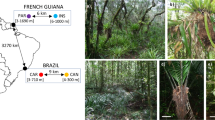Abstract
Genetic relatedness of the mound-building ant Formica pratensis was determined by means of microsatellite DNA polymorphism, and its impact on nestmate recognition was tested in a population in Southern Sweden (Oeland). Recognition between nests was measured by testing aggression levels between single pairs of workers. The genetic distances of nests (Nei's genetic distance) and the spatial distance of nests were correlated and both showed a strong relation to the aggression behavior. Multiple regression analysis revealed a stronger impact of genetic relatedness rather than spatial distances on aggression behavior. Neighbouring nests were more closely related than distant nests, which may reflect budding as a possible spreading mechanism. The genetic distance data showed that nestmate recognition was strongly genetically influenced in F. pratensis.
Similar content being viewed by others
Author information
Authors and Affiliations
Additional information
Received: 2 October 1997 / Accepted after revision: 10 January 1998
Rights and permissions
About this article
Cite this article
Beye, M., Neumann, P., Chapuisat, M. et al. Nestmate recognition and the genetic relatedness of nests in the ant Formica pratensis . Behav Ecol Sociobiol 43, 67–72 (1998). https://doi.org/10.1007/s002650050467
Issue Date:
DOI: https://doi.org/10.1007/s002650050467




